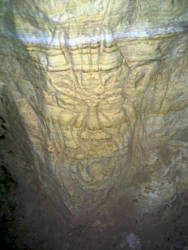Geotopes named after the Devil


The "devil" appears in many names of caves, rock formations and gorges. These names usually date back to the Middle Ages and are mostly based on myths and legends. In those days, people often explained mysterious or eerie natural formations in mythical terms. The devil symbolises darkness and the uncontrollable, and thus places that people in the past did not understand or feared. A connection to the devil is often found in the following cases:
- Frightening landscape: Darkness, rumblings, fog or deep holes whose depth could not be determined are closely associated with the hell described in the Bible, which is also characterised by eerie landscape, vapours or fog, and terrible noises.
- Assumed artificial origin: Something that is relatively rare and whose origin cannot be explained is often assumed to be artificial. "It can't have come about like that, someone made it that way artificially." And when it comes to frightening things, especially those that exceed human craftsmanship, the idea of it being the work of the devil is not far off.
- Folk myths: Legends and tales tell of pacts with the devil, petrified figures or battles between saints and the devil for moral instruction. In general, it is quite popular to interpret things in rock formations or stalactites, such as the Madonna and Child, Elvis, or even the devil. And so the legend, which does not specify a location, suddenly has a place.
And so it comes about that many places, especially caves, which were avoided in the Middle Ages out of fear, were assumed to have a connection with evil or the supernatural. In Christian-influenced areas, the inexplicable or dangerous was referred to as the work of the devil. The names "devil" and "hell" were intended to signal danger and deter people. The use of witches, dragons, dwarves or giants in names works quite similar.
Today, of course, this name is still used, and the tourist effect is considerable. Such names remain catchy and arouse curiosity. They allow for spectacular images in brochures or bombastic works of art on site. The significant disadvantage, of course, is the high risk of confusion. There are plenty of devil’s caves; in Germany alone, there are two show caves with this name. Unfortunately, such names are a double-edged sword.
The examples here are only a subset, and there are quite different types of geotopes named after the devil. As you can easily see the risk of confusion is really high. We have therefore made it a habit to include the place name, i.e. the location where they are located, in the name and search for all these frequently used names. The Cueva del Diablo in the city of Mazatlán, in Sinaloa, Mexico, thus became Cueva del Diablo Mazatlán. A corresponding search yields significantly better results, even if many incorrect results still come up.
- Examples
 Puente del Diablo, Argentina
Puente del Diablo, Argentina Devil’s Coach House, Australia
Devil’s Coach House, Australia Дяволското гърло - Devil’s Throat, Bulgaria
Дяволското гърло - Devil’s Throat, Bulgaria Devil’s Hole, Bermuda
Devil’s Hole, Bermuda Caverna do Diabo, Brazil
Caverna do Diabo, Brazil Devil’s Bridge, Antigua & Barbuda
Devil’s Bridge, Antigua & Barbuda Teufelsschlucht, Switzerland
Teufelsschlucht, Switzerland Museo Mina Chiflón del Diablo, Chile
Museo Mina Chiflón del Diablo, Chile Teufelsschlucht, Germany
Teufelsschlucht, Germany Besuchsbergwerk Teufelsgrund, Germany
Besuchsbergwerk Teufelsgrund, Germany Teufelshöhle, Germany
Teufelshöhle, Germany Teufelshöhle, Germany
Teufelshöhle, Germany Cueva del Diabolo, Spain
Cueva del Diabolo, Spain Ventano del Diablo, Spain
Ventano del Diablo, Spain Devil´s Hole, Great Britain
Devil´s Hole, Great Britain Devil’s Punchbowl, Great Britain
Devil’s Punchbowl, Great Britain Wurt Pit and Devil’s Punchbowl, Great Britain
Wurt Pit and Devil’s Punchbowl, Great Britain Cueva del Diablo Mazatlán
Cueva del Diablo Mazatlán Cueva del Diablo, Bolivia
Cueva del Diablo, Bolivia Pailon del Diablo, Ecuador
Pailon del Diablo, Ecuador Devil’s Den Cave, United States of America
Devil’s Den Cave, United States of America Devil’s Den, United States of America
Devil’s Den, United States of America Devil’s Icebox Cave, United States of America
Devil’s Icebox Cave, United States of America Devil’s Ice Box, United States of America
Devil’s Ice Box, United States of America Devil’s Den, United States of America
Devil’s Den, United States of America Devil’s Kettle, United States of America
Devil’s Kettle, United States of America Devil’s Millhopper, United States of America
Devil’s Millhopper, United States of America Devils Punchbowl, United States of America
Devils Punchbowl, United States of America Devil’s Sinkhole, United States of America
Devil’s Sinkhole, United States of America Devil’s Well, United States of America
Devil’s Well, United States of America Dust Devil Mine, United States of America
Dust Devil Mine, United States of America
- See also
 Search DuckDuckGo for "Geotopes named after the Devil"
Search DuckDuckGo for "Geotopes named after the Devil" The Devil Made Me Do It: Why So Many Wild Places Are Called Hell This or Hell That (visited: 13-NOV-2025)
The Devil Made Me Do It: Why So Many Wild Places Are Called Hell This or Hell That (visited: 13-NOV-2025) The Troubling Reason So Many American Places Are Named After The Devil (visited: 13-NOV-2025)
The Troubling Reason So Many American Places Are Named After The Devil (visited: 13-NOV-2025) A Hell Of A Place: The Devil's Role In National Park Place Names (visited: 13-NOV-2025)
A Hell Of A Place: The Devil's Role In National Park Place Names (visited: 13-NOV-2025) Devil Places - Sharon A. Hill (visited: 13-NOV-2025)
Devil Places - Sharon A. Hill (visited: 13-NOV-2025)

 Index
Index Topics
Topics Hierarchical
Hierarchical Countries
Countries Maps
Maps